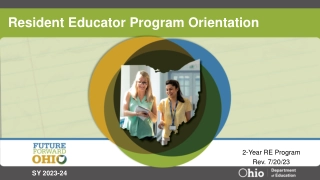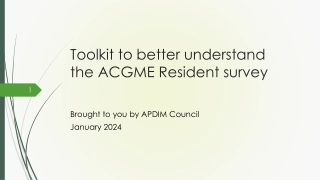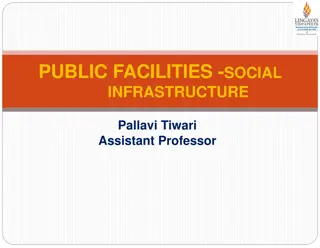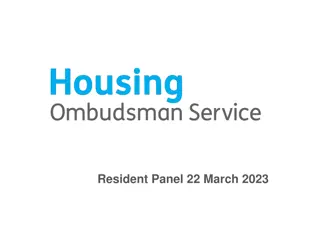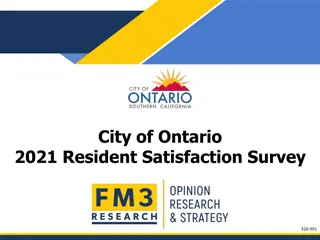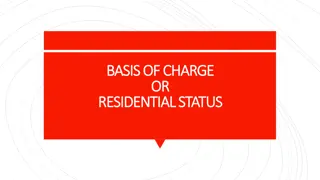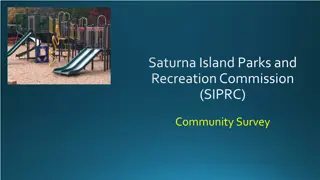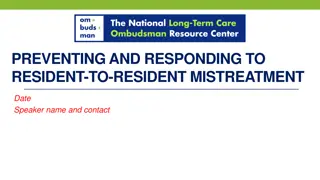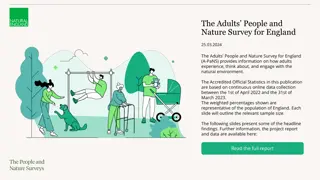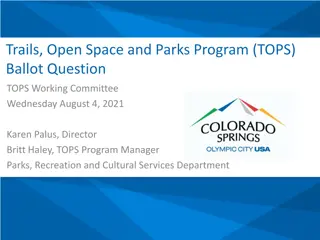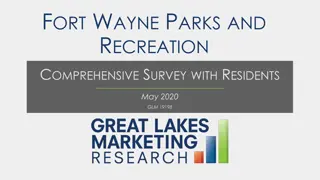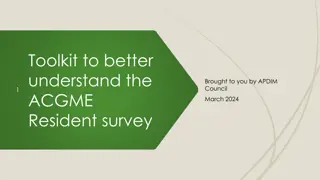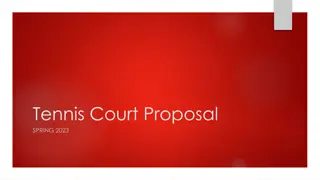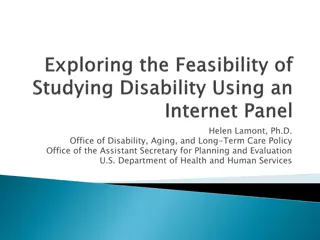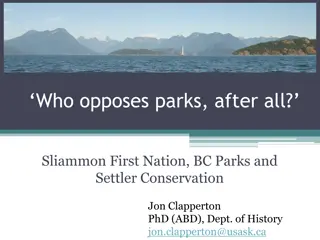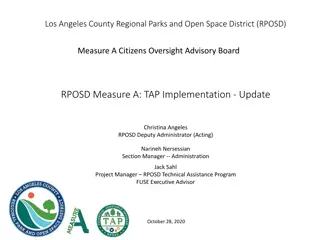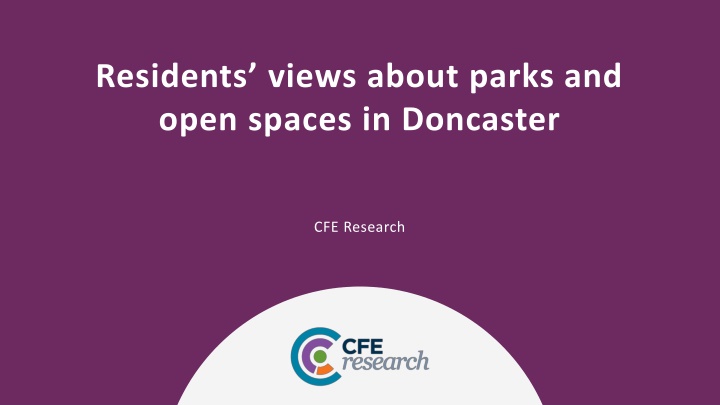
Residents' Views on Parks and Open Spaces in Doncaster: Insights & Perceptions
Gain valuable insights into residents' perceptions of parks and open spaces in Doncaster through a recent survey. Discover how the community values these spaces, their impact, and the role of residents in supporting them post-COVID-19. Explore demographics, volunteering activities, and more to understand the significance of green areas in urban environments.
Download Presentation

Please find below an Image/Link to download the presentation.
The content on the website is provided AS IS for your information and personal use only. It may not be sold, licensed, or shared on other websites without obtaining consent from the author. If you encounter any issues during the download, it is possible that the publisher has removed the file from their server.
You are allowed to download the files provided on this website for personal or commercial use, subject to the condition that they are used lawfully. All files are the property of their respective owners.
The content on the website is provided AS IS for your information and personal use only. It may not be sold, licensed, or shared on other websites without obtaining consent from the author.
E N D
Presentation Transcript
Residents views about parks and open spaces in Doncaster CFE Research
Contents These slides contain the findings from the Residents Panel survey conducted between June and July 2021. The survey was completed by 157 residents. The findings cover: The characteristics of those responding to this survey Perceptions of parks and open spaces Use of parks and open spaces in Doncaster Perceptions of parks and open spaces in Doncaster Volunteering activity in parks Key insights
Demographic characteristics
Demographics of respondents Age Number of respondents Disability Number of respondents 16-24 13 No disability, mental health or illness 92 25-44 72 Yes, but no substantial impact on daily life 25 45-64 51 Yes, has substantial impact on daily life 38 65+ 21 Prefer not to say 2 Main employment status Number of respondents Gender Number of respondents Employee full-time 54 Male 51 Employee part-time 24 Female 106 Self-employed 11 Retired 22 Ethnicity Number of respondents Unemployed and seeking work 10 Student 7 White British 137 Not in work and looking after home or family 13 BAME 20 Prefer not to Long-term sick 16 0 say Other economic activity 0
Demographics of respondents Household composition Number of respondents Income Number of respondents One or more adults, no children 90 Low income 77 One adult with one or more children aged under 20 Other income 70 Two or more adults with one or more children aged under 47 Unknown 10 In an Active Number of respondents Communities area Yes 47 No 114 Physical activity level when joined the panel Number of respondents Physically inactive 43 Physically active at least once a week 114
Perceptions of parks and open spaces
Residents perceptions of parks and open spaces The majority of residents recognise the importance of parks and open spaces and the benefits they bring to their community. 2 in 3 residents (68%) appreciate parks and open spaces more now than before the COVID-19 pandemic. Whilst 9 in 10 (89%) recognise that communities have a role to play in supporting parks and open spaces, 7 in 10 (72%) agree they were better cared for in the past, and 6 in 10 (66%) agree that people do not value parks and open spaces. Proportion agreeing 96% Parks and open spaces are important to the community and should be protected (n=156) 5% 90% 6% 92% Parks and open spaces have the potential to improve the quality of life for residents (n=155) 10% 82% 5% 91% There are wide-ranging benefits from having parks and open spaces (n=156) 7% 84% 5% 89% Communities have a role to play in supporting parks and open spaces from decline (n=157) 17% 72% 8% 87% It is important to me that there is a park or open space close to where I live (n=157) 4% 9% 78% 6% 12% 80% Parks and open spaces in Doncaster have a range of uses (n=155) 22% 58% 5% 17% 72% Parks and open spaces were better and more cared for in the past (n=149) 5% 18% 54% 4% 21% 68% I appreciate parks and open spaces more than I did prior to the COVID-19 pandemic (n=156) 7% 24% 44% 6% 19% 66% People today just don t value parks and open spaces (n=156) 10% 22% 44% 7% 19% 63% Parks and open spaces are more important for families and young people (n=156) 12% 10% 53% 0-2 3-4 5 6-7 8-10 Q1. To what extent do you agree or disagree with the following statements about parks and open spaces, such as areas of grassland or woodland?
Use of parks and open spaces in Doncaster
Regularity of use 1 in 4 residents (26%) had used a park or open space in Doncaster at least 4 times a week in the last month, and a further 2 in 5 (39%) had used a park or open space at least once a week. At least 4 times a week 26% At least once a week 39% - Non active community residents used parks and open spaces more regularly, with 3 in 10 (33%) doing so at least 4 times a week compared with 1 in 10 (11%) active community residents. At least once a fortnight 15% Residents who had used a park or open space at least once in the last month, but less than once a fortnight, highlighted a variety of reasons that prevented them from doing so more regularly. Reasons included lack of time, health problems, and anti-social behaviour putting them off using parks and open spaces. At least once a month 15% Not at all 6% Only 9 residents (6%) had not used a park or open space in the last month. I like going to the parks with my small grandchildren, when I am well enough to go, but I always feel intimidated by youths on the parks smoking and drinking, taking over the park, stopping the smaller children from playing. - The majority either did not have time or used the gym instead - 3 had used a park or open space previously 1 did so at least once a week and 2 at least once a month Q2. How regularly have you used a park or open space, such as areas of grassland and woodland, in Doncaster in the last month? N=157 Q3. What are the main reasons you do not use/regularly use a park in Doncaster? N=32 Q5. Have you previously use a park or open space, such as areas of grassland and woodland, in Doncaster? N=9 Q6. How regularly did you use a park or open space, such as areas of grassland and woodland, in Doncaster? N=3
Regularity of use compared to before the pandemic Half of residents have increased the frequency of their visits to parks and open spaces compared with before the COVID-19 pandemic. I have significantly increased the frequency of my visits to parks and open spaces 22% I have slightly increased the frequency of my visits to parks and open spaces 33% - 50% of residents in active communities areas have slightly increased their use of parks and open spaces compared with 26% of non active community residents. There has been no change in the frequency of my visits to parks and open spaces 36% - Just under 1 in 5 (17%) active community residents have not changed the frequency of their visits compared with over 2 in 5 (44%) non active communities residents. I have slightly decreased the frequency of my visits to parks and open spaces 3% I have significantly decreased the frequency of my visits to parks and open spaces Encouragingly, only 6% of residents have decreased the frequency of their visits to parks and open spaces. 3% Not sure 2% Q4. How regularly does your use of parks or open spaces, such as areas of grassland and woodland, in Doncaster compare now to before the COVID-19 pandemic? N=148
Length of time spent in parks and open spaces Most (92%) residents spend 30 minutes or more (on average) in a park or open space each time they visit. More than 2 hours 8% Active community residents spend longer in parks and open spaces each time they visit than non active community residents, with almost half (49%) spending 1 to 2 hours per visit compared with just 1 in 3 (31%) non active community residents. Therefore, they may use parks less but stay there longer when they visit. 1 to 2 hours 36% 30 minutes to 1 hour 48% Less than 30 minutes 8% Q11. How long do you/did you usually spend on average in a park or open space, such as areas of grassland and woodland, in Doncaster each time you visit? N=151
Travelling to parks and open spaces Almost 2 in 3 residents travel by foot to reach parks and open spaces in Doncaster The majority of residents want to visit a local park or open space they do not want to spend much time travelling. - More female residents (67%) travel by foot, compared with males (49%). - 6 residents (4%) do not want to spend any time travelling (most of these do not use the park). - More males (49%) travel by car or motorbike, compared with females (27%). - Only 1 in 5 (18%) residents are willing to travel for more than 30 minutes. Length of time residents are willing to spend travelling Method of transport Less than 5 minutes 5% By foot 62% 5-10 minutes 26% By car or motorbike 33% 11-20 minutes 28% 21-30 minutes 19% By bus 3% More than 30 minutes 18% I do not want to spend any time travelling to parks or open spaces Other 2% 4% Q12. What is/was the main way you travel to reach a park or open space, such as areas of grassland and woodland, in Doncaster? N=151 Q13. How many minutes are you willing to spend travelling to a park or open space, such as areas of grassland and woodland, in Doncaster? N=157
Reasons for using parks and open spaces in Doncaster Main reason Residents use parks and open spaces for a variety of reasons. To play with my children/family outing 48% 28% For relaxation and contemplation 48% 15% - Playing with children/family outings, and for relaxation and contemplation were the most frequently cited reasons. To undertake outdoor physical activity or sport including walking 15% 36% - Undertaking exercise or exercising a pet were also commonly cited reasons, as were observing wildlife and meeting with friends. To exercise a pet 25% 36% 4% To observe wildlife/nature 33% When asked what the main reason was, over 1 in 4 residents (28%) reported they did so to play with their children or to go for a family outing and 1 in 4 (25%) did so to exercise a pet. Only 15% stated physical activity when not exercising a pet. To meet with friends 31% 4% 5% To visit a play area 29% 3% To take a short cut 12% To attend an event, such as a concert, dance or exhibition 1% 9% Whilst observing wildlife or nature, and meeting friends were common reasons to visit a park or open space, they were not the main reason to do so for the majority of residents To engage in education 0% 5% 1% Other Q7. How For which of the following reasons do you/did you use parks or open spaces in Doncaster? N=151 Q8. Which is/was the main reason you used parks or open spaces in Doncaster? N=151
Physical activity or sport in parks and open spaces Over 2 in 3 residents had used a park or open space to undertake physical activity or sport within the last month. Walking was by far the most common type of physical activity undertaken, as reported by over 8 in 10 (85%) residents, followed by informal sports, as reported by 1 in 5 residents (20%). Regularity of use Physical activity undertaken Walking 85% At least 4 times a week 20% Informal sports (e.g. kick around with family or friends) 20% At least once a week 28% Running/jogging 11% At least once a fortnight 10% Cycling 11% Using outdoor gym equipment (e.g. exercise bikes, rowing machines and pull-up bar) At least once a month 10% 7% Organised sport (e.g. with a sports club or team) 4% Not at all 30% Outdoor fitness classes 4% Don t know 1% Other 5% Q9. How regularly have you used a park or open space, such as areas of grassland and woodland, to take part in physical activity or sport in Doncaster in the last month? N=148 Q10. Which of the following types of physical activity have you participated in within Doncaster s parks and open spaces? N=101
Perceptions about parks and open spaces in Doncaster
Access to and appeal of parks in Doncaster The majority of residents agree that they are aware of parks and open spaces available in Doncaster, there is a park or open space within walking distance to their home, feel able to access them for physical activity, and are prepared to travel to parks and open spaces. But for a significant minority this is not the case. However, 2 in 3 (67%) residents agree that other parts of the country have better parks and open spaces (34 residents also stated don t know ). Whilst 2 in 3 (62%) agree that parks and open spaces in Doncaster have something for everyone, 1 in 3 (33%) disagree that there are sufficient activities on offer to encourage them to use parks and activities on a regular basis. There is also a perception for many that parks are mainly used by parents (58%). Proportion agreeing 4% 5% 86% There is a park or open space within walking distance from my home (n=153) 5% 10% 76% I am aware of the parks and open spaces that are available in Doncaster (n=153) 7% 11% 76% 5% 27% 49% 7% 15% 72% I feel able to use/access the local park for physical activity (n=149) 7% 20% 52% 7% 15% 71% I am prepared to travel to reach a park or open space in Doncaster (n=151) 7% 19% 52% Other parts of the country have better parks and open spaces than Doncaster (n=119) 8% 16% 67% 9% 24% 43% 11% 19% 62% Parks and open spaces in Doncaster have something for everyone (n=151) 8% 26% 36% 12% 13% 58% Parks and open spaces are mainly used by parents with children (n=152) 17% 30% 28% There are sufficient activities on offer in Doncaster s parks and open spaces to encourage me to use them on a regular basis (n=145) 21% 21% 46% 12% 20% 26% 0-2 3-4 5 6-7 8-10 Q14. To what extent do you agree or disagree with the following statements about parks and open spaces, such as areas of grassland and woodland, in Doncaster?
Barriers to using parks in Doncaster Only half (53%) of residents feel safe in Doncaster s parks and open spaces all the time and over 8 in 10 (85%) residents avoid Doncaster s parks and open spaces at night. More males (40%) strongly agree (scoring 8-10) that they feel safe in parks and open spaces all the time compared to females (22%). Almost 2 in 3 residents agree that the behaviour of others discourages them from using Doncaster s parks and open spaces. More residents from the active communities (60%) strongly agree with this (scoring 8-10) compared with non active community residents (33%). Over half (55%) of residents do not see people like them exercising in Doncaster s parks and open spaces. More residents with a disability that has a substantial impact on their daily life (56%) strongly agree with this (scoring 8-10) compared with those who do not have a disability (31%). More residents who are physically inactive (53%) also strongly agree with this compared with those who are physically active (32%). Proportion agreeing 8% 85% I avoid Doncaster's parks and open spaces at night (n=153) 4% 8% 76% The behaviour of others discourages me from using parks and open spaces in Doncaster (n=153) You don't see people like me exercising in Doncaster's parks and open spaces (n=143) 10% 14% 64% 12% 23% 41% 16% 14% 55% 15% 17% 38% 17% 15% 53% I feel safe in Doncaster s parks and open spaces all of the time (n=150) 15% 25% 28% Time constraints prevent me from making more use of parks and open spaces in Doncaster (n=153) Parks and open spaces in Doncaster are only enjoyable in the summer months (n=151) I prefer different types of recreation to that on offer in Doncaster's parks and open spaces (n=140) 11% 18% 50% 22% 25% 24% 11% 15% 44% 30% 19% 25% 13% 26% 43% 18% 19% 24% 0-2 3-4 5 6-7 8-10 Q14. To what extent do you agree or disagree with the following statements about parks and open spaces, such as areas of grassland and woodland, in Doncaster?
Factors to engage residents in using parks in Doncaster Residents agree that they would undertake a range of activities in parks and open spaces, and almost 3 in 4 residents (72%) agreeing that parks and open spaces need to be about more than just physical activity and playing. 8 in 10 residents (81%) agree that they would attend entertainment events, and 2 in 3 residents (63%) agree they would attend education events in parks and open spaces. 2 in 3 residents (64%) also agree that they would make more use of parks and open spaces if they were more welcoming in appearance. Half of residents (49%) agree that they would participate in physical activity in parks and open spaces if sessions were organised. More active community residents (48%) strongly agree with this (scoring 8-10) than non active community residents (25%). Proportion agreeing I would attend entertainment events in Doncaster's parks and open spaces (n=151) 7% 81% 7% 23% 59% Parks and open spaces need to be about more than physical activity and playing (n=149) 8% 14% 72% 6% 23% 49% I would make more use of parks and open spaces in Doncaster if they were more welcoming in appearance (n=153) 7% 18% 64% 11% 23% 41% 7% 19% 63% I would attend education events in Doncaster's parks and open spaces (n=144) 10% 19% 44% I would participate in physical activity in Doncaster's parks and open spaces if there were organised sessions (n=146) 12% 17% 49% 22% 17% 32% 0-2 3-4 5 6-7 8-10 Q14. To what extent do you agree or disagree with the following statements about parks and open spaces, such as areas of grassland and woodland, in Doncaster?
Current and future volunteering in parks 19 residents (12%) currently volunteer their time to activities in the park e.g. litter picking, events or as part of a Friends of Park group. 68% Would volunteer in the future 11% Would possibly volunteer in the future 26% Encouragingly, the majority of those who already volunteer either plan to continue doing so in the future (68%) or will possibly do so (26%). 40% Would not volunteer in the future 0% 26% 1 in 10 (11%) of those who do not currently volunteer would do so in the future and a further 4 in 10 (40%) possibly would. 5% Not sure 23% Currently volunteer Do not currently volunteer Q15. Do you currently volunteer your time to any activities in the park, such as litter picking, events of as part of a Friends of Park group? N=157 Q16. Would you volunteer/continue to volunteer your time to any activities in the park, such as litter picking, events or as part of a Friends of Park group? N=157
So, what does this mean? Residents recognise the value of parks and open spaces, and appreciate them more now than they did prior to COVID- 19. But they feel others do not value them and they are not as well looked after as they were in the past. Half of residents have increased the frequency of their visits to parks and open spaces compared with before COVID-19. Whilst active community residents still use parks and open spaces less frequently than non-active community residents, they are more likely to have increased the frequency of their visits since the outbreak of the pandemic, and the average length of their visits is longer. There is also no difference by how frequently they use a park or open space to undertake physical activity and not everyone feels able to access the park for this purpose. Most residents are aware of parks and open spaces in Doncaster and agree there is a park within walking distance to their home. This is important as most residents do not want to spend much time travelling to parks and open spaces. Residents currently use parks and open spaces to play with children/go on a family outing, or to undertake outdoor physical activity or sport. However, they agree that parks and open spaces need to be about more than physical activity and playing, and agree that they would use parks for various other activities if these were available. However, there are various barriers which prevent residents from using parks and open spaces, including others behaviour and safety, and residents avoiding using them at night. Residents also highlighted that they would make more use of them if they were more welcoming in appearance. There is also the perception that parks are mainly used by, and are important for, parents and/or families. Residents recognise that communities have a role to play in supporting parks and open spaces, but only a minority currently volunteer to help with their upkeep. Half of residents who do not currently volunteer, would either do so or possibly do so. Therefore, there is potential appetite to increase the number of people who volunteer in parks and open spaces to meet the Future Parks objectives.

